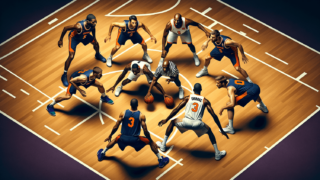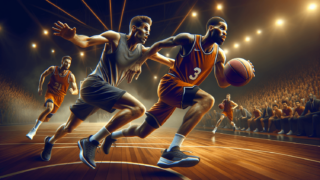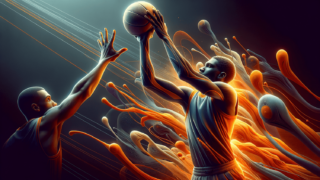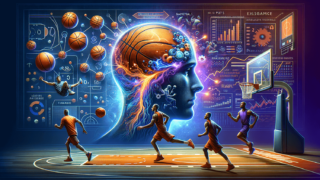
Welcome to the dynamic world of basketball, where developing lightning-fast reaction time is crucial to achieving success and boosting performance on the court! In this blog post, we will delve into the essential techniques and drills that can help you sharpen your reflexes and improve your situational awareness on the court. If you’re ready to unlock your basketball potential and become a basketball juggernaut, then strap on your sneakers and join us as we explore the ins and outs of enhancing your basketball reaction time!
How to Improve Your Basketball Reaction Time?
To improve your basketball reaction time, focus on incorporating key elements such as strengthening your cognitive skills, practicing sport-specific drills, and utilizing visual and anticipatory techniques. Participate in exercises that target your decision-making, hand-eye coordination, peripheral vision, and situational awareness. Additionally, strive to maintain a healthy lifestyle, stay consistent in your training, and engage in activities like playing video games or learning a musical instrument to improve cognitive function and reaction time.
Get Your Head in the Game: Strengthen Cognitive Skills
Improving your basketball reaction time starts with honing your cognitive skills. By training your decision-making, attention, and memory, you’ll become more agile and quick-thinking on the court. Here are some ways to strengthen these valuable cognitive skills:
Exercise Your Brain
Like any muscle, your brain needs exercise to stay strong and sharp! Engage in challenging activities like puzzles, memory games, and brain teasers to keep your mind stimulated and primed for quick decision-making during basketball games. Don’t be afraid to mix it up – the more varied the activities, the better your overall cognitive development will be.
Stay Educated and Informed
Expanding your knowledge base by reading books, watching educational videos, or taking online courses can improve cognitive function by increasing neural connections. With a strong foundation in intellectual and analytical skills, you’ll be better equipped to make split-second decisions on the basketball court, ultimately improving your reaction time.
Tackle Sport-Specific Drills
Increasing your basketball reaction time goes hand-in-hand with mastering sport-specific drills. These targeted exercises will help you build the physical and mental skills necessary to react quickly on the court.
Change-of-Direction Drills
One of the most crucial aspects of basketball is the ability to change directions instantly while maintaining control and speed. Drills like the T-Drill, 5-10-5, and Ladder Shuffle can help you enhance your agility and quickness on the court.
Defensive Slide Drills
Quick switches between offensive and defensive play are essential for optimizing reaction time. Working on defensive slides will help you stay on your toes, move quickly laterally, and react effectively to your opponents. Incorporate drills like the Lane Slides, Zig Zag Drill, and Mirror Drill to improve your defensive slides and overall reaction time.
Ball-Handling Drills
Excellent ball handling is critical for success in basketball. Drills that simulate pressure and force you to make fast decisions will improve your reaction time during gameplay. Some popular ball-handling drills include the Dribble Tag, Two-Ball Dribbling, and Tennis Ball Toss.
Train Your Vision and Anticipation
Reaction time in basketball heavily depends on your ability to perceive and process visual cues. Developing skills related to vision and anticipation will significantly boost your reaction time.
Expand Your Peripheral Vision
Having a strong command of your peripheral vision allows you to see and react to plays on the court effectively. A good place to start is by using the “Look Away” method, which involves looking forward while trying to perceive objects or scenes in your peripheral vision. Gradually increase the distance and complexity of the objects for maximum effectiveness.
Visual Training Techniques
Specific exercises can help improve visual acuity, eye-tracking, and depth perception – all crucial aspects of the basketball game. Popular techniques include the Brock String, the 3D VMS Training, and the Eye-Swap Drill. By incorporating these exercises into your routine, you’ll be better prepared to make rapid decisions based on visual cues during gameplay.
Embrace the Power of Video Games
While not traditionally associated with sports training, video games can help improve cognitive performance and reaction time. Several studies have shown a positive correlation between video game play and enhanced attention, hand-eye coordination, and split-second decision-making – all essential components to up your basketball game.
Choose Games That Target Cognitive Skills
Pick video games that require strategy, quick decision-making, and complex problem-solving for the best results. Action-packed games, real-time strategy games, and even online multiplayer games can help stretch your cognitive muscles and improve your basketball reaction time.
Remember Moderation
While video games can be an effective tool for improving your reaction time, moderation is key. Don’t let gaming overtake your basketball practice and physical training, as these activities remain the most crucial components of your overall basketball performance.
Stay Consistent with Your Training
To see consistent improvement in your basketball reaction time, it’s important to maintain a regular practice and training schedule. Make a commitment to continuing your reaction-time practice and focusing on the principles outlined in this blog post. With consistency and dedication, you’ll see noticeable improvements in your reaction time and overall basketball performance.
Become a Basketball Maestro
Through activities like learning a musical instrument, you’re actually training your brain to process information quickly, reinforcing mental focus, and enhancing timing and dexterity. These skills are easily transferable to basketball and could help improve your reaction time on the court.
Maintain a Healthy Lifestyle
Adopting a healthy lifestyle will support your cognitive function, physical condition, and overall performance on the basketball court. For peak performance, ensure you:
Get Adequate Sleep
It’s essential to prioritize sleep, as it affects your cognitive abilities, memory, and mood. Aim for 7-9 hours of restful sleep per night to support optimal cognitive functioning and quick reaction times on the court.
Fuel Your Body with Proper Nutrition
A well-balanced diet with lean protein, healthy fats, and complex carbs will help keep your body energized and your mind sharp. Stay hydrated with water and electrolyte beverages during training sessions and games for optimal cognitive function, physical endurance, and reaction time.
Train and Condition Your Body
Physical power plays a direct role in your basketball performance, so incorporating strength and conditioning exercises is crucial for getting faster and more explosive on the court, ultimately improving your reaction time.
By incorporating these principles and techniques, you’ll be well on your way to mastering advanced basketball skills and improving your basketball reaction time. Remember, consistent practice and dedication will get you the results you’re aiming for. So, keep at it and transform into a force to be reckoned with on the court!
Master the Art of Relaxation
Many athletes tend to tense up when the game is on the line or under high-pressure situations. Being calm and relaxed is the key to optimizing reaction time and making better decisions on the basketball court. Here are some strategies for managing stress and staying composed during games:
Deep Breathing Exercises
Deep breathing can help lower stress levels and promote relaxation, improving your cognitive function and ability to react quickly during gameplay. Practice deep, conscious breathing before games and during breaks to reset your mental state and enhance focus.
Mental Visualization
Visualizing successful plays in your mind before a game can reduce anxiety and boost confidence. Take time to mentally rehearse the game situation, and visualize yourself making quick, effective decisions on the court. This mental preparation will help improve your reaction time and overall performance.
Learn from the Pros
Watching professional basketball players in action can provide invaluable insights into how they think, move, and react during games. By observing their techniques and strategies, you can identify patterns and approaches that may help you improve your own reaction time on the court.
Watch Game Footage
Analyzing game videos of top players can reveal tactics and techniques that contribute to their lightning-fast reaction times. Break down their actions and decision-making processes, and incorporate these insights into your own practice and gameplay.
Attend Basketball Camps and Workshops
Participating in basketball camps and workshops led by experienced coaches and professional players can provide valuable guidance on improving your reaction time. Learn from their expertise, apply their advice, and incorporate their tips into your practice to become a faster and smarter basketball player.
Buddy Up: Practice with a Partner
Training with a partner is an excellent way to improve your basketball reaction time, as it introduces an element of unpredictability and mimics real-game situations. Partner drills can effectively help you hone your defensive and offensive reaction times:
Reaction Ball Drills
Using a reaction ball, a ball with an irregular shape that doesn’t bounce predictably, is a fun and challenging way to enhance your reaction time. Perform drills that require you to catch, dribble, or defend the reaction ball, pushing yourself and your partner to react faster each time.
The Live Drill
The Live Drill simulates one-on-one gameplay with a partner, allowing both players to react quickly to the other’s moves. By constantly adapting your actions to your partner’s movement, you will continually sharpen your reaction time during real-game situations.
From mastering relaxation techniques to learning from the pros and practicing with a partner, incorporating these additional strategies into your basketball training will enable you to unlock your full potential on the court. Commit to enhancing your reaction times, and watch as you elevate your basketball skills to new heights.
Frequently Asked Questions
Here are some of the most commonly asked questions related to improving your basketball reaction time, complete with concise answers to help you in your journey to becoming a better basketball player.
1. How long will it take to see improvements in my basketball reaction time?
The time it takes to see improvements varies from person to person, depending on factors such as individual athleticism, practice frequency, and prior experience. With consistent practice and dedication, most individuals can expect to see noticeable improvements in reaction time after several weeks or months of focused training.
2. Can I improve my basketball reaction time by playing other sports?
Yes, participating in other sports can help improve your reaction time indirectly, as it helps develop overall athleticism, coordination, and situational awareness. Sports like soccer, football, and tennis, which require quick decision-making and lightning-fast reactions, can be particularly beneficial for basketball players.
3. How important is reaction time in basketball compared to other skills?
While reaction time is an essential skill in basketball, it’s just one aspect of a player’s overall skill set. Other critical skills include ball handling, shooting, defense, and communication. To become the best basketball player you can be, it’s essential to work on all aspects of your game, including reaction time.
4. Can I improve my reaction time through mental training alone?
Mental training can play a significant role in improving your reaction time, but it should not replace physical practice entirely. Combining both mental and physical training provides the most comprehensive approach to optimizing your basketball reaction time.
5. How can I measure my reaction time improvements?
One way to measure improvements in reaction time is by tracking your performance in specific drills designed to test reaction time, such as the 5-10-5 Drill or the Tennis Ball Toss Drill. Additionally, observing your in-game performance and noting faster decision-making during play can also indicate an improvement in reaction time.
6. What age group can benefit from these reaction time improvement strategies?
Individuals of all ages can benefit from implementing these reaction time improvement strategies, as they cater to various skill levels and athletic abilities. However, younger players may experience more significant improvements due to their developing physical and cognitive capabilities.
7. How much time should I dedicate to practicing reaction time exercises each week?
There is no set amount of time one should dedicate solely to practicing reaction time exercises, as it will vary based on individual goals, schedules, and overall training routines. Integrating reaction time exercises into your regular basketball practice schedule and dedicating time to mental training and sports-specific drills regularly will prove most beneficial.
8. Are there any negative impacts of focusing too much on reaction time?
Focusing too much on reaction time could potentially detract attention from other critical skills, such as shooting or defense. To ensure comprehensive skill development, it’s essential to incorporate reaction time training into a broader basketball practice routine that focuses on various skillsets.
9. Can reaction time be improved through group drills or team activities?
Yes, group drills and team activities can be excellent ways to improve reaction time, as they simulate real-game scenarios and facilitate communication between players. Incorporating team exercises that focus on quick decision-making and rapid response during practice sessions can be beneficial for all team members.
10. Are there any risks associated with implementing these reaction time improvement strategies?
As with any athletic training, there is a risk of injury or overtraining when implementing reaction time improvement strategies. It’s crucial to listen to your body, prioritize proper form during exercises, and allow for sufficient rest and recovery to minimize the risk of injury and optimize your training efforts.
Featured Posts
- No pillar pages found.





